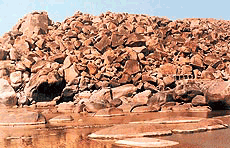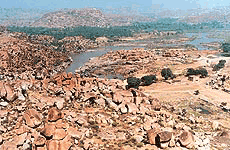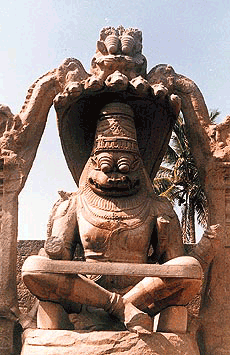Amid the rocks and ruins of Hampi
Like human beings, gods
fought among themselves, fought for their people and
married and had their consorts. This necessarily
increased the rituals of the temples and the number of
ceremonial enclosures. Marriage as culmination of human
love was something divine and, therefore, a matter of
central concern for divine beings too. Thus, in the
Vitthalaswami temple, as well as in the Hazara Rama
temple, Amman shrine was built for the gods’
consort. Open-pillared Kalyana mandapa was built to
receive the pair in an annual marriage ceremony, observes
Arun
Gaur
A few months ago celebrations were held at
the temple of Virupaksha and the loftiest gopuram on
the bank of the Tungbhadra was painted yellow. And now it
is neither an antique monument nor a modern structure. At
Kalpi, they have painted white the treasury on the
Yamuna, where Rani Lakshmibai conferred with Tantya Toppe
and Nana Sahib. At Orchha, they have painted some of the
domes pink and built pink tourist lodges on the Betwa
where the mediaeval cenotaphs of kings stand.
Mythological
associations of the principal temple are quite clear.
Pampa was the daughter of Brahma and Virupaksha —
the lord of Pampa.
 Before the temple is the famous bazar
of Hampi. Just near it sit two monolithic giant Ganeshas
— Sasivikallu, the mustard seed stone and
Kadalikallu, the gram grain stone. Some distance away is
the ferocious monolithic Narasing. Just above the bazar
and rocks, I find a scattered group of painters from the
Mysore Arts College. "Hoysala is good too. But the
perspective that Hampi provides is something
different." Every student makes his own assessment
of colours and forms. Some see the rocks as dark some as
light. A student makes the textures and configurations
sharp. Others make the structure and rocks melt into each
other. Before the temple is the famous bazar
of Hampi. Just near it sit two monolithic giant Ganeshas
— Sasivikallu, the mustard seed stone and
Kadalikallu, the gram grain stone. Some distance away is
the ferocious monolithic Narasing. Just above the bazar
and rocks, I find a scattered group of painters from the
Mysore Arts College. "Hoysala is good too. But the
perspective that Hampi provides is something
different." Every student makes his own assessment
of colours and forms. Some see the rocks as dark some as
light. A student makes the textures and configurations
sharp. Others make the structure and rocks melt into each
other.
In the river, granite
rocks are smooth and convex like the backs of tortoises
unlike the irregular granite rocks in the Betwa of Orchha
that appear to be like crocodiles. If one follows the
bank of the river one reaches the Vitthalaswami temple.
Like human beings, gods
fought among themselves, fought for their people and
married and had their consorts. This necessarily
increased the rituals of the temples and the number of
ceremonial enclosures. Marriage as culmination of human
love was something divine and therefore a matter of
central concern for divine beings too. Thus in the
Vitthalaswami temple as well as in the Hazara Rama
temple, Amman shrine was built for the god’s
consort. Open-pillared Kalyana mandapa was built to
receive the pair in an annual marriage ceremony.
Brick work is becoming
bare in one gopuram. It is risky to stand under
it. The elephant driven ratha, probably
monolithic, is placed separately. Its wheels turn. Beyond
the enclosure of the temple is Tungbhadra, green palm
trees and serpentine white passage. On the top is perhaps
a white Jaina establishment.
 The construction of this temple, grand in
conception and location, was perhaps started by
Krishnadevaraya and the Hazara Rama was the King’s
private temple, as is suggested by the high enclosure
walls. Though critics have found certain deficiencies in
the carving of figures in granite this grainy texture has
given these figures a peculiar charm that also marks the
images of the granite walls of Nilkantha temple of
Kalinjar. The construction of this temple, grand in
conception and location, was perhaps started by
Krishnadevaraya and the Hazara Rama was the King’s
private temple, as is suggested by the high enclosure
walls. Though critics have found certain deficiencies in
the carving of figures in granite this grainy texture has
given these figures a peculiar charm that also marks the
images of the granite walls of Nilkantha temple of
Kalinjar.
With an increase in the
power of the king, the religious art and rituals also
prospered and with it developed the power of the priest.
When the irrigation tanks burst, the priest told the king
that the deity wanted 60 human heads to be appeased, and
it was done. So tell some travellers. Brahmins, thus,
became powerful.
Pageants and processions
passed before the platform throne on certain occasions.
Soldiers sat on rocks. These pageants were well deserved
and hard earned. For had not the kings of Vijyanagar
empire, perhaps all alone in the entire south India kept
the Muslim forces at bay right upto the Battle of
Talikota (1565) when Ahmadnagar, Golkunda, and Bijapur
combined their might against Vijyanagar led by Rama Raja,
to destroy the Hindu empire?
While Rama Raja kept
himself busy in doling out prizes from his velvet throne,
from the enemy came cavalry and cannonade charges. The
king’s bearers fled, hurling him down. The king of
Vijyanagar empire was beheaded and speared. One lakh
persons were massacred, Ferishta states, and the
Malaprabha became red.
 Ferishta talks about the cruelty
perpetrated by the Hindus of Vijyanagar on Bijapur. The
same charges were made against the Muslims by the Hindu
historians. Nuniz’s account is coloured by his
intense gratitude to the king while Paes’ is too
dramatic and seems to betray a Portuguese complex. Ferishta talks about the cruelty
perpetrated by the Hindus of Vijyanagar on Bijapur. The
same charges were made against the Muslims by the Hindu
historians. Nuniz’s account is coloured by his
intense gratitude to the king while Paes’ is too
dramatic and seems to betray a Portuguese complex.
But undoubtedly the
ascension to the throne had not been an easy matter for
any king during the reign of the three dynasties—
the Sangama, the Saluva and the Narasinga (Taluva). Even
Krishnadevaraya had to gouge out the eyes of Salvatinica
who brought him up and gave him his kingdom.
When the defeat came in
the Battle of Talikota, the destruction particularly with
fire was carried out with such alacrity that there
remained almost nothing of the gorgeous city of
Vijyanagar. Seldom had ruin overtaken such splendid
palaces, temples and art works so briskly. Many of them
were made in wood and hence quickly turned to ashes.
Today almost everything is gone, but even the little that
remains is enough to suggest the glory that once was.
On the platform throne
there are images of women hunting, music players and
animals. Women wrestle and wielded swords. They fasted,
poured milk over the nagakals— stones carved
with cobras — soaked them in water and placed them
under the trees of margosa and pipal. They also performed
sati. Clad in yellow, holding a leafy branch of
betel, singing loudly a woman would ride a horse to
plunge into flames. She also carried a mirror and a comb
to prune herself up before she met her husband in the
other world.
One day I met Anna, a
tourist from Berlin, cycling just above the bank of the
Tungbhadra near the temple where Krishna reclines on the
Sheshnag. She sets her cycle against the wall of the
Achutya’s temple, then takes off her slippers and we
climb the Martangam Parvatam. Big rocks have gaping
crevices. We have to jump over them. I am tired. I rest.
She goes ahead to find the way and calls me up.
All around is a
rock-strewn country skirted by the river. This is the
land of the Tungbhadra to go to Anegundi, one has to
cross Tungbhadra by boat.
We have a final look at
the passage where the king must have galloped among the
rocks. And then, it is time to leave.

|

